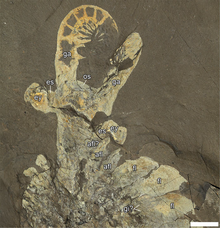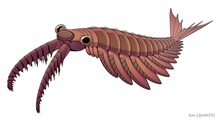| Anomalocaris | |
|---|---|

| |
| ROMIP 51212, a largely complete specimen of Anomalocaris canadensis | |

| |
| Life restoration of Anomalocaris canadensis | |
| Scientific classification | |
| Domain: | Eukaryota |
| Kingdom: | Animalia |
| Phylum: | Arthropoda |
| Order: | †Radiodonta |
| Family: | †Anomalocarididae |
| Genus: | †Anomalocaris Whiteaves, 1892 |
| Species | |
(8 more unnamed species[3]) | |
Anomalocaris ("unlike other shrimp", or "abnormal shrimp") is an extinct genus of radiodont, an order of early-diverging stem-group arthropods.
It is best known from the type species A. canadensis, found in the Stephen Formation (particularly the Burgess Shale) of British Columbia, Canada. The other named species A. daleyae is known from the somewhat older Emu Bay Shale of Australia.[2] Other unnamed Anomalocaris species are known from China and the United States.[3]
Like other radiodonts, Anomalocaris had swimming flaps running along its body, large compound eyes, and a single pair of segmented, frontal appendages, which in Anomalocaris were used to grasp prey. Estimated to reach 34.2–37.8 cm (13.5–14.9 in) long excluding the frontal appendages and tail fan,[4] Anomalocaris is one of the largest animals of the Cambrian, and thought to be one of the earliest examples of an apex predator,[5][6] though others have been found in older Cambrian lagerstätten deposits.
Since the original description in late 19th century,[7] the frontal appendages were the only known fossilized parts and misidentified as the body parts of other animals.[8] Its radiodont affinity was revealed in 1980s, specifically in a 1985 journal article by Harry B. Whittington and Derek Briggs.[9] The trunk and mouth were reconstructed after another radiodont genus until the corrections done in 1996[8] and 2012.[10] It is the type genus of Anomalocarididae, a family which previously included all radiodonts but recently only Anomalocaris and a few closely-related taxa.[3]
- ^ Cite error: The named reference
Lerosey-Aubril_2014was invoked but never defined (see the help page). - ^ a b Cite error: The named reference
Paterson-2023was invoked but never defined (see the help page). - ^ a b c Cite error: The named reference
Wu_2021was invoked but never defined (see the help page). - ^ Cite error: The named reference
Lerosey-Aubril_2018was invoked but never defined (see the help page). - ^ Cite error: The named reference
De_Vivo_1955was invoked but never defined (see the help page). - ^ Cite error: The named reference
Bicknell-2023was invoked but never defined (see the help page). - ^ Cite error: The named reference
Whiteaves-1892was invoked but never defined (see the help page). - ^ a b Cite error: The named reference
Collins_1996was invoked but never defined (see the help page). - ^ Cite error: The named reference
W&Bwas invoked but never defined (see the help page). - ^ Cite error: The named reference
Daley_2012was invoked but never defined (see the help page).